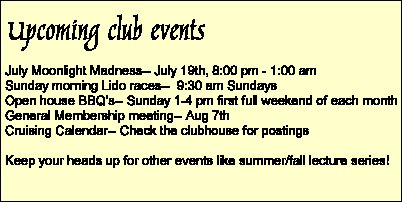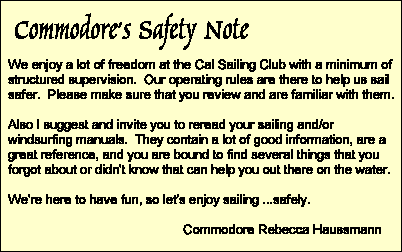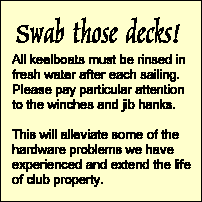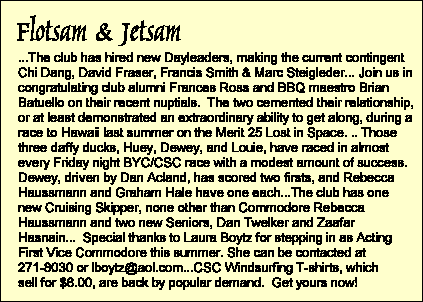![]()
The Floating Bottle
The Newsletter of the Cal Sailing Club
Summer 1997
From the editor
Welcome to the new incarnation of the Floating Bottle. If it looks different from what you remember, it's because the editor is also your thrifty treasurer and she is trying to cut costs. Less on printing, more on sailing equipment, she says.
But we have still managed to pack this issue with useful information on topics including tides, cruising and hypothermia.
Contributions for future issues are always welcome.
--Marceline Therrien, Floating Bottle
Editor, Treasurer & Junior Skipper

Low Tide Blues
But why can't I go sailing?
Newer members have voiced this refrain over the past few months, as the club has been closed some weekend mornings due to low tide.
One of the first lessons for those working toward their junior rating in the early spring is that sailing isn't an activity on-demand: wind is required. The second lesson is that you need water, too.
Everyone is familiar with the concept of tides. The moon revolves around the earth, and pulls the water in the oceans; this pull raises and lowers the water level, and so forth.
But the Lidos require perhaps two feet of water and windsurfers need nearly nothing, right?
Well, yes and no. While the boat or board you're sailing might not have much draft, remember there is another critical item afloat: the dayleader's skiff.
CSC provides an important resource you wouldn't have if you learned to sail from friends who own equipment---there is a dayleader on duty at all times, with a motorized skiff in the water, ready to rescue you.
For those of us who haven't been sailing for years, that dayleader is very reassuring. It's the skiff that requires 2.5 feet of water, and without the skiff, there's no sailing for those who haven't earned a Senior rating.
Two and a half feet is about 1' above `Mean Lower Low Water,' or mllw, the reference that people use when they talk about tides. Since mllw can be thought of as the average of all the lowest water levels each day, it's not uncommon for the tide to fall below 1.0' above mllw.
This is fairly easy to remember. Unfortunately, it doesn't translate into times quite so well. Tide is moderately predictable, however, so we can do what all good sailors do: look at the tide tables. These are available as small booklets at stores that sell sailing supplies.
Nowadays, technically intrepid sailors can program a computer to calculate the tides and generate an operating hours table.
However, since wind can push water as well as sailboats across the bay, altering the water level significantly, not all of that precision is to be believed.
In any event, the actual depth of water as measured by the dayleader is the ultimate, unappealable test.
The club web site has an operating hours chart (http://www.well.com/user/csc/lowtide.htm), and a copy of this table is available at the club. Put a copy on your refrigerator, and you'll never sing that sad refrain. Thankfully, there are no closures expected due to low tide until the fall.
--by Richard Reitmeyer, Junior Skipper

Instruction
Summer fun...
With the arrival of summer comes an increase of sun, wind, and new and returning members. The demands on the club increase with new members wanting to learn how to sail-- NOW!
The busiest lesson day is Saturday. This is the day our volunteer instructors should make a special effort to get down to the club to offer their services. On a typical Saturday a teacher can earn at least 3 lesson credits toward next quarter's membership---not a bad deal for a few hours spent sailing on the Bay!
Monday and Thursday offer less crowds. It's a great opportunity for students to speed up their learning process since they typically don't have to wait for lessons and can generally get more than one lesson in a day.
Wednesday evening from 6:00 to 9:30 is still the time to receive instruction in our venerable Ensigns. This class is primarily for Junior Skippers who wish to develop their skills in keelboats. However, it is open to all members regardless of their rating.
We spend about 2/3 of the time sailing around the harbor learning how to control a larger boat in confined spaces--something that develops confidence in your sailing abilities.
We also offer keelboat lessons on the weekend, subject to the availability of instructors.
So grab your foulies and get involved!
--by Peter Baczek, Rear Commodore
and Cruising Skipper
For those interested in learning to windsurf, the rigging lesson takes from 1 1/2 to 2 hours and covers not only the proper way to rig a sail, but also covers club procedures for damaged equipment, equipment location, sail carrying, and proper dock launching techniques. This lesson is held every Saturday morning at 9:30 am.
In addition to the rigging lesson, we also have scheduled windsurfing lessons that take place every Saturday beginning at 10:00 am. These usually involve some time on the simulator behind the club house, and then some time on the water.
What is taught depends on the level of the students, but in general it is aimed at the beginners that need help in up hauling, sailing upwind, tacking, and perhaps jibing.
--Bill Moseley, Senior Windsurfer

Safety
Hypothermia.
Editors note: Sailing is a fun, non-contact (generally) sport that gets you out into the fresh bay breeze. Normally, the worst you get is an occasional bruise. However, as in all sports, there are some inherent dangers.
One of the greatest safety risks that we face at the Cal Sailing Club is hypothermia. Hypothermia is the lowering of the body's core temperature through exposure to water, wind, or cold temperatures.
The most rapid, and therefore most dangerous way to lose heat is through direct contact with chilly bay water. We are also exposed to wind and spray. Evaporation of moisture from the body will rapidly lower body temperature.
Prevention
The best treatment for hypothermia is to prevent its onset. Most importantly, try to stay dry.
If you are just beginning to sail or have a limited budget, purchase plastic rain gear or rummage through the club's foul weather gear in the equipment locker.
Underneath, wear wool or synthetics. Avoid cotton clothing.
Most heat is lost from your head, so wear a wool cap or even just a baseball cap. A wool cap stays on in high winds and capsizes.
If you know you will sail often, invest in good quality foul weather gear and/or a wetsuit. Windsurfers, of course, wear wetsuits.
But don't be fooled, even a wetsuit can be inadequate protection against the cold water and strong winds of the bay.
Remember, the Dayleader may not be able to reach you quickly, so you need to know the limits of the boat, your crew, and yourself. Stay on the dock or sail in the inner area if you are reaching those limits.
Signs
Monitor yourself and others for signs of hypothermia and if present, seek shelter from the wind and cold water as soon as possible.
The signs and symptoms of hypothermia can be deceiving. Nevertheless, there are some general guidelines. Muscles become tense, shivering may begin, and fatigue and weakness begin to show. Movements usually become less coordinated.
It is critically important to halt the progression of hypothermia in its early stages. Worsening of the condition may result in mental confusion and lack of proper judgment, further endangering your well-being.
The symptoms of moderate hypothermia include a slowing or stopping of shivering, stiff muscles, mental confusion, and apathy. Speech may become slow, vague, and slurred. Breathing may become slow and shallow. Drowsiness or strange behavior may occur.
Treatment
Proper first aid is essential. For MILD hypothermia, get the person into the clubhouse, close the windows and doors, and turn on the heater.
Seat or lay the person down on the bench and next to the heater. Replace wet clothing with dry layers, and cover the head and neck. It is important to warm the person gently and gradually.
Once on the way to recovery, a warm beverage may be helpful but do not administer drinks containing alcohol or caffeine.
MODERATE to SEVERE hypothermia is life threatening and must be treated as a medical emergency.
The dayleader or an appointed club member will contact emergency medical personnel by dialing 911 at the nearest pay phone.
While awaiting help, follow the guidelines for mild hypothermia.
The most happy sailors are those who are comfortable, and being cold is definitely not comfortable. A few proper articles of clothing and the use of good judgment will make sailing at the Cal Sailing Club much more enjoyable.
I'll see you (warm and dry) on the water!
--by Dan Twelker, Port Captain
and Senior Skipper

Cruising
There and back again
Although I am Commodore of the Cal Sailing Club, I didn't cruise much, even as crew, until I started giving qualifying cruises for my cruising rating. I wanted to be a Cruising Skipper so that I would have the option to travel in the Bay with the keelboats.
Cruising seemed uninteresting to me. It felt like you go sailing, you get somewhere, you sail back and it takes all day.
Now that I have cruised frequently (and have completed my cruising rating), I say.. "All right!" Cruising is great! You go sailing, you get somewhere, you sail back, and it takes all day!
The only difference is now I know how fun it is.
You start out by going sailing, which is great fun. There's no better place to be than out in the sun with the wind in your face. There are sights that you can only see out on the Bay. Sea lions bark at you and giant salmon do startling belly flops.
Then you get somewhere. You go to some really cool spots that can be as varied as the weather you find around the Bay. You can sail to a quaint historical site, a glittery tourist spot, or a quiet bay-side village -- the list goes on.
After you've visited some special place you go home by -- what else -- taking another great sail. And still there is no better place to be than sailing.
There is a plethora of sailing destinations around the Bay. You can sail out the Golden Gate and play in the big swells of the Pacific. You might even see a dolphin or two.
Angel Island is always a favorite trip. It's a bit closer than most and can't be beat for a nice hike, picnic and a view of the Bay that's most grand.
Point San Pablo is the quintessential "quaint bay hideaway", with a neat folksy marina, and a galley cafe to meet all your culinary needs.
On one cruise up to Point San Pablo during the weekend of the Vallejo Race, there was nothin' but spinnakers as far as the eye could see. From horizon to horizon they filled the entirety of the Bay. It seemed like every spinnaker in the proximity of the Bay was out there flying . All making their way like floating flowers on a stream downwind to their mark.
The list of sights and destinations goes on. But my vote is in.
Cruising is pure fun.
--Rebecca Haussmann, Commodore
& Cruising Skipper
People and Numbers
Executive Committee Members
| Name | Rank | What they do | Phone | |
| Rebecca Haussmann | Commodore | She who must be obeyed | 528-6945 | srop@ix.netcom.com |
| Brandon Gates | Vice Commodore | Publicity hound | 215-0600 | |
| Martin Scanlan | First Vice Commodore | Keeps Lidos floating | 547-1631 | sangha@uclink4.berkeley.edu |
| Matthias Reinsch | Second Vice Commodore | Keeps Windsurfers flying | 848-9260 | mwreinsch@lbl.gov |
| Abizar Lakdawalla | Third Vice Commodore | Keeps Keelboats sailing | 549-9186 | abizarl@aol.com |
| Peter Baczek | Rear Commodore | Docking the ducks lessons | 530-1135 | pbaczek@baylinks.com |
| Dan Twelker | Port Captain | Oversees Dayleaders | 236-6799 | twelker@uclink4.berkeley.edu |
| Bill Csajko | Secretary | Doesn't fetch coffee | 945-0461 | wcsajko@spd.usace.army.mil |
| Marceline Therrien | Treasurer | Ms. Moneybags | 208-5460 | spice@sirius.com |
Other Folks
| Name | Position | What they do | Phone |
| Bill Csajko | Captains Committee Chair | Crusty old commodores | 945-0461 |
| Scherazade Sohrabji | Membership Chair | Knows everyone | 843-8878 |
| Chris Binger | Social Chair | Guru of fun | 883-0603 |
| Dan Acland | Racing Chair | Arbitrary arbitration of rules | 559-8040 |
| Cindy Ross | Windsurfer Lockers | Indirect house cleaning | 526-5010 |
| Marceline Therrien | Floating Bottle Editor | This fine publication | 208-5460 |
| Hester Burn Callander | YRA Memberships | Folks with boats | 415-388-5116 |
| Jennifer Kirkland | Banquet Chair | Chef extraordinaire | 370-3796 |
| Ted Wilson | Cruising Chair | Head of the high seas | 939-3822 |
| Elizabeth Simon | Rating Committee Chair | Testing 1-2-3 | 548-7527 |
| Peter Kuhn | Motor Maintenance | Putt, putt | 549-9588 |
| Martin Schaaf | Disability Access Chair | Open to everyone | 814-9979 |
| Tim Brandon | T-shirt Chair | Keeps us clothed | 549-9875 |
| Bill Csajko | Webmaster | Surfs the web, sails the Bay | 945-0461 |
| Peter Baczek | Sail Maintenance | Patches the rags | 530-1135 |
Rating Committee Members
| Name | Phone | Rates |
| Elizabeth Simon | 548-7527 | D,K,W |
| John Green | 939-8459 | D,K |
| Dan Acland | 559-8040 | D,K |
| Graham Hale | 444-6334 | K |
| Peter Baczek | 530-1135 | D,K |
| Scott Hotes | 528-2654 | D,K |
| Brian Battuello | out of town | D,K |
| Paul Kamen | 540-7968 | D,K |
| Louis Benainous | 527-3942 | D,K |
| Peter Kuhn | 549-9588 | D |
| Tim Brandon | 549-9875 | K |
| Bill Moseley | 832-7617 | W |
| Thomas Bregante | 489-1400 | K |
| Robert Ofsevit | 528-3711 | D,K |
| David Cary | (415) 341-6585 | D,K |
| Bill Prinzmetal | 236-5013 | W |
| Charles Clausen | (541) 476-1475 | D,K |
| Trilbus Regentin | 864-9511 | W |
| Bob Collins | 848-0873 | K |
| Saul Schumsky | 420-8097 | K |
| Ed Corbett | (702) 853-8055 | D,K |
| Clive Scullion | 268-8863 | D,K,W |
| Bill Csajko | 945-0461 | D,K |
| Ken Shepherd | 843-0500 | K |
| John Danielson | (916) 982-1889 | D,K |
| Ed Shirk | 548-1477 | D,K |
| Jim Fair | (415) 967-6207 | D,K |
| Ted Wilson | 939-3822 | D,K |
| Bill Gavelis | 595-1763 | D,K |
| Eric Wittig | 223-7619 | D,K |





